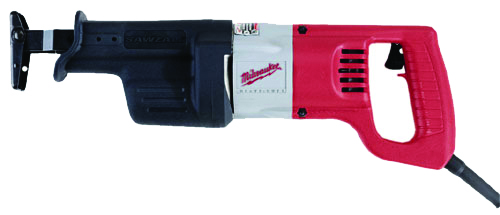A Sawzall looks like a robotic arm—or at least, forearm. A slender blade is attached to a bulky body. A Sawzall does pretty much what its name promises: saws everything—wood, metal, even concrete if you have the correct blade. It is crude, but incisive.
What makes the Sawzall different from a table saw, circular saw, and chain saw—indeed, what makes it neoclassic— is that it is the only mobile mechanical adaptation of the crosscut motion. The crosscut technique, in its most pedestrian manifestation, is that of the standard handsaw—a basic drawing back and forth motion that has been used from the time Vikings built their warships up until today, when Boy Scouts cut lengths of wood for birdhouses. The more romantic image of a crosscutting saw is of a two-man lumberjack team ripping a long blade back and forth, a handle at each end.
The Sawzall not only adapted the crosscutting motion for the Atomic Age when it was invented, in 1951, but it perhaps preserved the technique from being relegated to the back of the toolbox. Mind you, the momentum toward disfavoring the crosscut method was not an instant evolutionary left turn, like VHS tapes wiping out Beta in a matter of years. Instead, it took nearly two hundred years to marginalize the cross-cutting technique.
Just around the time the industrial era was dawning in the late eighteenth century, simple mathematics was married to sawing. In 1780, twelve years before the cotton gin and twenty-seven years before the conveyor belt, a German engineer, Gervinus, invented the first circular saw.
By allowing for continuous cutting, the circular saw blade promised new efficiency for the major commercial applications of sawing—logging and construction. Even so, for more than a century, the steam-powered circular saws were far too cumbersome to lug deep into the woods or up into the rafters of a construction site.
But then, almost simultaneously in the 1930s, mobile circular saws and chain saw designs popped up almost everywhere there were houses and trees. A farm equipment repairman in western Washington State remarks in his journal that farmers in the region were bringing him their homemade gas-powered chain saws for repair. By 1950, a Swedish motorcycle manufacturer, Husqvarna, was mass-producing chain saws. At the same time, Sears, Roebuck and Co. was distributing tens of thousands of electrically powered circular saws annually.
But the circular saw had limitations for home building and construction. Unless the circular saw blade has a surface or substance to sink its teeth into, the centrifugal force pushes the blade away from objects like freestanding pipes. The circular saw also cannot plunge its blade into a flat surface, for projects like slicing out a hole for a window.
In 1951, just as chain saws were tearing through the Chippewa Falls region of Wisconsin with alarming efficiency, a young engineer, Jerome Schnettler, partnered with Milwaukee Electric Tool Corporation to design a saw with what he called a “reciprocating action.” Like taking the awesome power of a two-man Vermont lumberjack team and shrinking the men to the size of a bread box, the Sawzall could tear through pipes, quickly cut awkward pieces of wood, and execute a “plunge cut.”
In 2002, Schnettler, the Sawzall’s inventor, was inducted into the Machine Tool Hall of Fame.
This summer I started work on a run-down house in Portland, Oregon. Located in a once crime-ridden neighborhood, the house was surrounded by a chain link fence that, as a welcoming gesture to my neighbors, I tore down. But I was left with pipes set deep into concrete. A few friends suggested using a blowtorch to cut away at the pipes’ bases. Finally, my neighbor loaned me his Sawzall. It cut through the (concrete-filled) pipes like butter.





